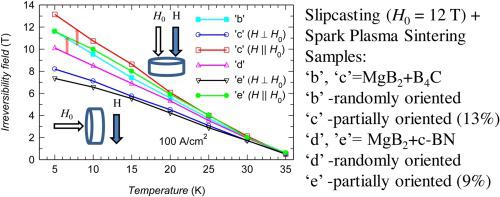当前位置:
X-MOL 学术
›
Mater. Res. Bull.
›
论文详情
Our official English website, www.x-mol.net, welcomes your
feedback! (Note: you will need to create a separate account there.)
Partially-oriented MgB2 superconducting bulks with addition of B4C and cubic BN obtained by slip casting under high magnetic field and spark plasma sintering
Materials Research Bulletin ( IF 5.3 ) Pub Date : 2021-02-01 , DOI: 10.1016/j.materresbull.2020.111103 M.A. Grigoroscuta , G. Aldica , I. Pasuk , M. Burdusel , V. Sandu , A. Kuncser , T.S. Suzuki , O. Vasylkiv , P. Badica
Materials Research Bulletin ( IF 5.3 ) Pub Date : 2021-02-01 , DOI: 10.1016/j.materresbull.2020.111103 M.A. Grigoroscuta , G. Aldica , I. Pasuk , M. Burdusel , V. Sandu , A. Kuncser , T.S. Suzuki , O. Vasylkiv , P. Badica

|
Abstract Partially-oriented MgB2 bulk discs (13 and 9 %) with the starting compositions of (MgB2)0.99(B4C)0.01 and (MgB2)0.99(c-BN)0.01 were fabricated by slip casting under an H0 = 12 T magnetic field (perpendicular to the disc surface) and subsequent spark plasma sintering. The maximum critical current density and irreversibility field are for H//H0 (H=applied field). These values are higher or similar to the randomly-oriented samples with the same composition. The maximum volume pinning force (Fp) is lower in the partially-oriented ones than in the randomly-oriented samples. The pinning-force-related parameters depend on the additive and orientation. Assessment of the major pinning mechanism within the scaling and percolation models considering these parameters shows significant limitations. A method to scale Fp is proposed; for the randomly and partially-oriented samples (that show an extra peak in Fp), the single and double Gaussian functions fit well. The results suggest an anisotropic influence of carbon substituting for boron in the MgB2.
中文翻译:

通过在高磁场和放电等离子烧结下通过粉浆浇铸获得添加 B4C 和立方 BN 的部分取向 MgB2 超导块体
摘要 在 H0 = 12 T 磁场下通过粉浆浇铸制造了起始成分为 (MgB2)0.99(B4C)0.01 和 (MgB2)0.99(c-BN)0.01 的部分取向 MgB2 块状圆盘(13% 和 9%) (垂直于圆盘表面)和随后的放电等离子烧结。最大临界电流密度和不可逆场适用于 H//H0(H=外加场)。这些值高于或类似于具有相同成分的随机取向样品。部分取向样品的最大体积钉扎力 (Fp) 低于随机取向样品。与钉扎力相关的参数取决于添加剂和方向。考虑到这些参数,对缩放和渗透模型中的主要钉扎机制的评估显示出明显的局限性。提出了一种缩放 Fp 的方法;对于随机和部分定向的样本(在 Fp 中显示一个额外的峰值),单高斯函数和双高斯函数拟合得很好。结果表明在MgB 2 中碳替代硼的各向异性影响。
更新日期:2021-02-01
中文翻译:

通过在高磁场和放电等离子烧结下通过粉浆浇铸获得添加 B4C 和立方 BN 的部分取向 MgB2 超导块体
摘要 在 H0 = 12 T 磁场下通过粉浆浇铸制造了起始成分为 (MgB2)0.99(B4C)0.01 和 (MgB2)0.99(c-BN)0.01 的部分取向 MgB2 块状圆盘(13% 和 9%) (垂直于圆盘表面)和随后的放电等离子烧结。最大临界电流密度和不可逆场适用于 H//H0(H=外加场)。这些值高于或类似于具有相同成分的随机取向样品。部分取向样品的最大体积钉扎力 (Fp) 低于随机取向样品。与钉扎力相关的参数取决于添加剂和方向。考虑到这些参数,对缩放和渗透模型中的主要钉扎机制的评估显示出明显的局限性。提出了一种缩放 Fp 的方法;对于随机和部分定向的样本(在 Fp 中显示一个额外的峰值),单高斯函数和双高斯函数拟合得很好。结果表明在MgB 2 中碳替代硼的各向异性影响。











































 京公网安备 11010802027423号
京公网安备 11010802027423号